AgriVision's 2023 stories
-
 Paul Polman
Paul Polman -
 Brett Stuart
Brett Stuart -
 Morgaine Gaye
Morgaine Gaye -
 David Bravo
David Bravo -
 Talash Huijbers
Talash Huijbers
Moving from Linear to Regenerative Models
Saving the planet means saving ourselves – and the time for it is now
If we want to feed the future, we need to move away from our current linear food production model, said business leader and campaigner, author and former CEO of Unilever Paul Polman. As #AgriVision 2023 keynote speaker, Polman called for a shift in mindset toward a regenerative, purposeful and collaborative production model that can help us future-proof proteins. He urged leaders to take responsibility for their total impact on the planet, operate for the long term, and forge the broader partnerships we need to change the system and create a future where both humans and the planet thrive, sharing insights from his book, Net Positive: How Courageous Companies Thrive By Giving More Than They Take.
On the verge of tipping points
According to Polman, we’re at a point where the Earth’s capacity to absorb our unsustainable behaviour – particularly carbon emissions and waste – is coming to an end. Despite global efforts to reduce our carbon footprint, emissions are up 10% this decade when they should be down 45%. “The world has been incredibly flexible and increased its capacity to absorb our CO2 emissions, but this capacity has run out. We are very close to negative tipping points,” he warned.
Nearly a decade ago, Polman helped develop the UN 2030 Sustainable Development Goals. Since the onset of COVID-19, there has been a slowdown in progress on these goals, with only 12% on target today and the world experiencing increases in poverty, inequality and climate change. Polman said that while many of us might not realise the seriousness because we’re in a relative comfort zone, there are currently one billion people going to bed hungry and 100 million climate refugees, a number that could swell to one billion by 2030. “We are literally playing with the future of humanity,” he said.
Polman called on delegates to respond with speed and scale to decarbonise our global economies and address these inequalities. “The timeframe we have is very short and the scale of the change we need to make is greater than at any time in history,” said Paul. He said while people often talk about saving the planet, it's actually humans who need to be saved. With about a million species at the point of extinction, he asks, “When is it our turn?”
Our direction is good but more speed is needed
“The good news is things are moving,” said Paul. “People understand the devastating effects of climate change.” He sees governments moving in the right direction, with three times more climate-change related legislation enacted in the last decade than in the previous one. And companies are moving too, with more setting science-based targets and committing to become net zero.
The agriculture industry is also making progress, though he said we’re not moving fast enough. “The notion that food and land use systems are an integral part of the solution is now centre of the discussions on climate change, and rightfully so.”
He said the biggest change we’re seeing is in attitudes among employees, who only want to work for companies that have a higher purpose. “A recent study we did shows that about 50% are ready to quit if the companies don't deliver on what they promised and 30% have already actively done so.”
Bottom line: it's about not direction anymore, it's about speed and scale. He said the danger of these successes is a false sense of complacency. “I would argue that despite this enormous progress, it is actually more urgent to push faster than what we did before.”
Our industry can make a big difference
Polman said collaboration across the farming and food sector can make a meaningful difference in supporting a thriving world. Agriculture contributes about 30% of greenhouse gas emissions in its human-centric efforts to supply food as a basic human right. “The beauty of it is that we can take action to be 30% of the solution and we have a faster way to get there compared to the fossil fuel industry,” noted Polman.
Failure to act will have a rising cost
Polman said that, for companies, being less bad simply isn’t good enough anymore. “The only way to work your business model longer term is to think restorative, reparative, regenerative. And that is what we call net positive. And the cost of not acting has become significantly higher than the cost of acting.”
He pointed to ESG funds outperforming non-ESG funds over the long term. And for the agriculture industry, he estimated that while the investments required to shift toward regenerative models may amount to about $150-200 billion annually, the potential payoff is much larger. He said studies suggest these investments may yield a $4 trillion positive impact. “For every dollar invested, you get a $15 return, if you do it right.”
Polman said the window is quickly closing on the opportunity to curb emissions and keep the earth’s temperature within 1.5C◦ of pre-industrial levels. If we stay on our current trajectory, we will incur costs of around $178 trillion to our global GDP in 2070. But if we are able to slow the pace to 1.5C◦ degrees above preindustrial levels, the economic benefit could total a whopping $43 trillion.
Changing mindsets: restorative, reparative, regenerative
Polman said that to feed the future, we need to move from trying to make the agriculture value chain more resilient to actually making it regenerative. “The future is a biodiversity economy – a change from an output economy to an impact economy.”
Polman said a net positive company takes responsibility for its total impact in the world. “In the agriculture sector, only 5% of companies make commitments regarding their scope 3 emissions, yet 85% of all emissions are in this category. It’s great to make scope one and two emissions commitments, but frankly it doesn’t mean anything. You cannot outsource your value chain and also outsource your responsibilities.”
Polman said net positive businesses also focus on operating for the long term. And most importantly, they forge broader partnerships so they can work on the systems changes that are needed. “I've always said we should not compete on the future of humanity. In most cases it's actually better to make your whole value chain sustainable – it saves you 9 to 16%.”
Polman talks about how important leadership will be in driving this transformation. “You cannot become a sustainable company if you are not sustainable yourself. You cannot become a purpose-driven company if you are not purposeful yourself.”
Ultimately, he said, two questions that he poses in the book sum up what we should be asking ourselves: “How do you profit from solving the world's problems, not creating the world's problems? And finally, is the world better off because your company is in it?”
Polman said that the human-centric factor in moving towards a regenerative system will require leadership from the heart. “We need to bring humanity back to business. The biggest tragedy about climate change discussions is that we’ve made it a scientific not a human discussion. That’s why I like food – it brings us back to humans.” He said while we need profits, we should start not with shareholders, but with the people we serve. “If we don’t put people central, we’ll never get there.”
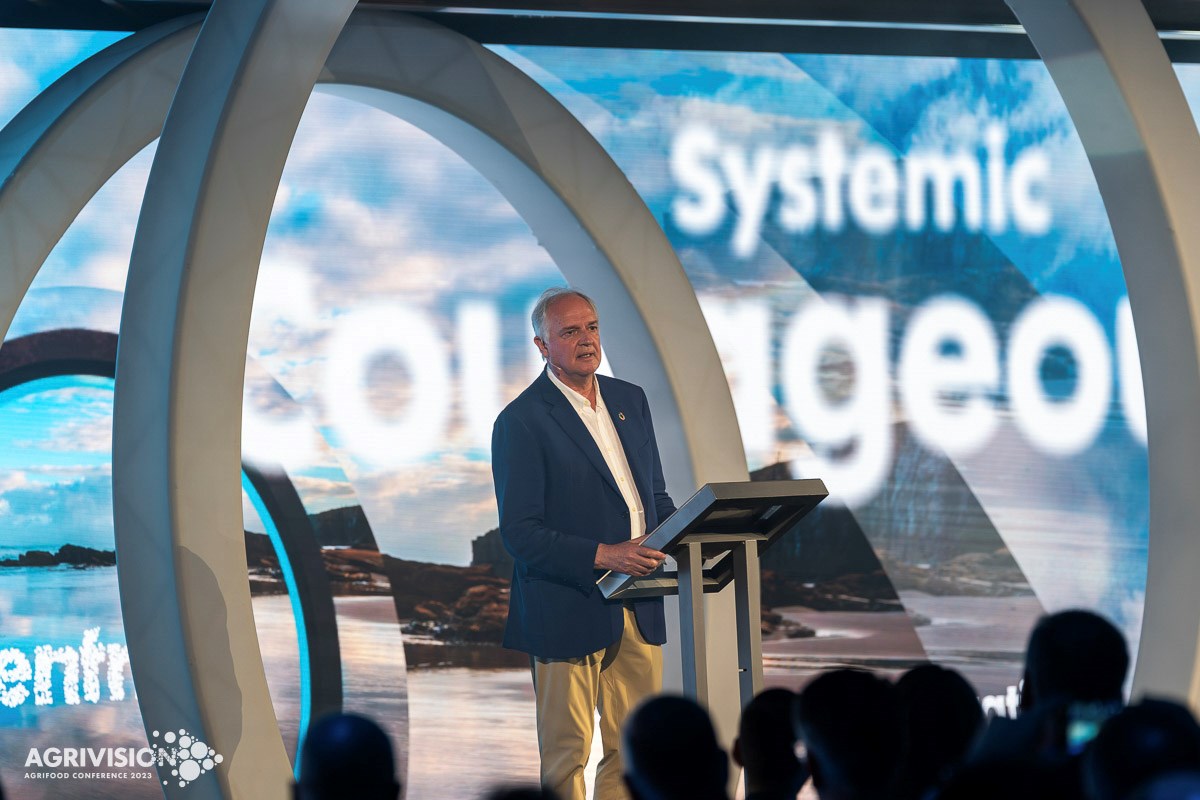
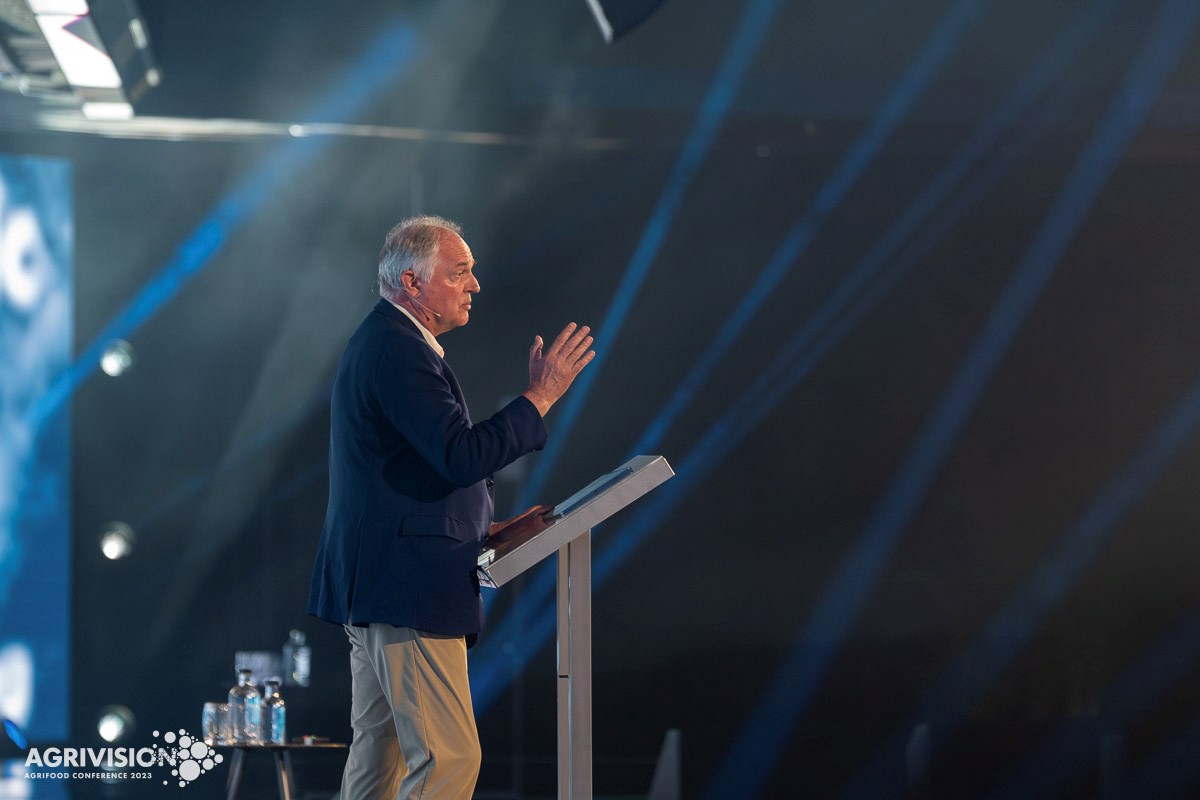
The future is unpredictable. Or is it?
This was the question posed by Brett Stuart, co-founder of Global Agri Trends, at #AgriVision 2023. After the global analytics forecaster and self-proclaimed data nerd read a book premised on the idea that anyone trying to predict the future is a fool, he thought carefully about his career choice. But on reflection, about the markets and his understanding of agriculture, he realised some trends are unmistakable – and he shared these with AgriVision 2023 participants. Stuart’s talk culminated in an optimistic message about the opportunities he believes the future holds for the livestock industry.
Megatrend 1: More mouths
Since 1800, we’ve added seven billion people to the world’s population, and are on track to reach nine or 10 billion by 2050. Stuart said that this incredible growth is one of the most interesting trends facing our industry. “If you could be involved in agriculture at any time in world history, when would you want to be involved? Now!” he said.
While the opportunities are vast, with one billion people already food insecure today – a situation he calls an “unacceptable” – we also face big challenges. Stuart says the problem is not production capacity. “Can we feed nine billion people by 2050? Absolutely, easily – if technology and productivity are allowed to spread globally.” He points to proof in the fact that while the U.S. and Europe have only 12% of the world’s dairy cows, they produce 45% of the world's milk due to technological advances. Despite having 76% of dairy cows, Brazil, India and China produce only 29%.
Megatrend 2: More money
Stuart says the global middle class is set to rise by almost three billion people from 2014 to 2030 – and we’re already seeing the impact. “It is absolutely incredible what's happened in global food demand just over the last ten years.” He ran a correlation between the global GDP and global meat and poultry consumption data sets and found the trends line up almost perfectly. As GDP increases, Stuart predicts that in the next 10 years we’ll need 75 million more tonnes of protein to meet demand. He says this will lead to rising prices for proteins, along with more opportunities for our industry to invest in productivity. “What is the market telling agriculture? Make more food. And they're going to be telling us that with profit, with prices, with huge opportunities to invest in technology productivity in a way that can truly feed the world.”
Megatrend 3: China
Stuart calls China, the largest growing market for agriculture imports, “fascinating.” While the Chinese population is now stable, and actually moving into a decline that could last for the next 50 years, Stuart says we’ve learned from countries like Japan and Italy that, even with a declining population, you still need more agriculture because of rising incomes – and this is also true in China.
“In the past year or so, China has doubled down on self-sufficiency. The Ministry of AG said food security – not military security – is a top priority.” He said the reality for China is that land is finite, while they have rising incomes in a steady population that wants more food. “Therefore, they have some tough decisions to make.” These trends have led China to lose self-sufficiency in almost every major commodity, becoming a major importer of corn, beans, rice, beef, pork, poultry, wheat and soybeans. “And this is a country that is very difficult to analyse, which will add uncertainty and volatility to our agriculture markets. If we end up in trade friction with China, leading to more trade actions, agriculture stands to lose the most.”
Megatrend 4: The wealthy 5% of the planet
Stuart talked about a major dilemma in agriculture related to the tension between the wants and needs of the wealthy and the 84% of the world that is currently in poverty. “Every farmer on the planet tracks yield and is constantly trying to improve productivity.” He mentions some buzzwords on the rise with consumers: organic, natural, antibiotic-free, free-range. “Every one of those practices reduces yield. This is the dilemma.” He suggests that the way to reconcile this dilemma is by preserving choice, which allows both producers and consumers to win. “Not everyone has $8 a gallon for organic milk. The inconvenient truth is that it’s socially irresponsible to legislate yield-reducing practices. With a billion people food insecure, now is not the time to legislate costs and regulations that reduce supplies.”
Sustainability opportunities abound for livestock industry
Stuart says that, while the livestock industry has been linked with higher emissions than it is actually responsible for, partially based on a later debunked 2006 UN report, there is no question it is a major emitter of greenhouse gases. He calls sustainability a fantastic opportunity for the industry. “This is all about sticks and carrots, right?” said Stuart. “The stick is legislation – having things forced upon you. The carrot is getting paid to make changes. The livestock industry works very well with carrots. You paint a target, and you give them some incentive and profit; they'll hit the target.”
He said sustainability presents big opportunities over the next five to 10 years, as more companies are forced to report their carbon footprints and need to buy offsets. “Where can we get offsets? If the livestock industry can figure this out – and there are a lot of ways to do it, including from feed additives – we're going to have a lot of carbon credits for sale.
Global dynamics ensure rising demand ahead
Stuart’s talk painted a picture of both threats and opportunities facing the global livestock industry in coming years, with the megatrends of more people and more money being clearly positive for global agriculture and the others a mixed bag. However, his overall message was an optimistic one – he believes that the global dynamics facing us ensure the agriculture industry will continue to see rising demand, and if the industry can adapt to the changes around us, its future is bright.
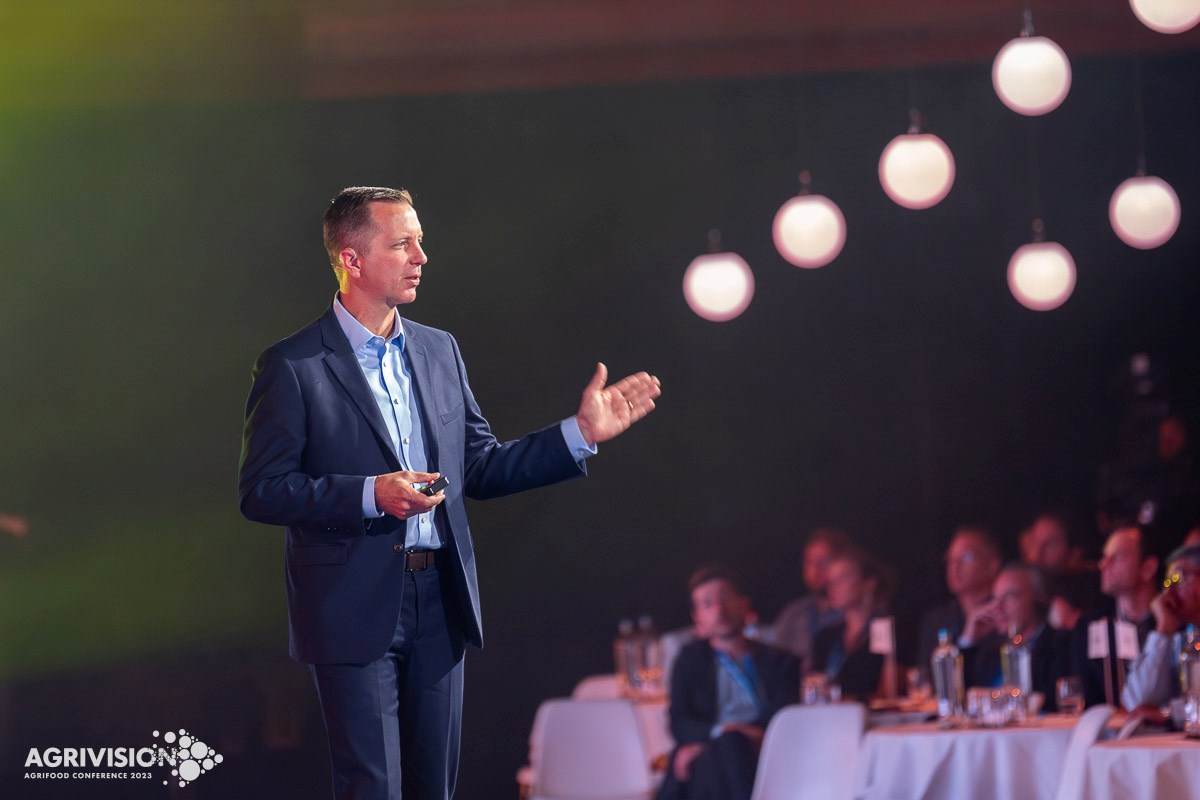

What does the future hold? One word sums it up
At AgriVision 2023, food futurologist Dr. Morgaine Gaye talked about the future of food, which is inextricably linked to other trends in society, from culture to taste to fashion. She said one word encapsulates where we’ve been in the last couple of years and where we’re going in the future: belongings.
Dr. Gaye said belongings worked on many different levels. “First, we have too many belongings, things we don’t need and that will be increasingly hard to get rid of. Next, we really want to belong – that became apparent during the pandemic, where we started to understand the power of the interconnectedness with friends and family. And we also have a longing, both for this perfect time in the past, but also for a better future, perhaps something that we can now co-create.” And finally, being: “it’s become super important to have time to just be, to spend time with ourselves.” Dr. Gaye talked about how this word will permeate trends over the next seven years.
She said that 2023 is the first opportunity we’ve had to stop and look back at what happened in 2020, and there will be more revelations based on that. “But 2023 will also bring more disruption; 2026 is when we’ll first start to have a bit of calm stability.” She said this means now is not the time to sit back and wait, but to do what we can to create the future we want to live in.
Some of the trends Dr. Gaye predicts will be important in coming years include:
- Insecurity: We’re seeing this, especially in the younger generations, and it is revealed in massive rebellion and public uprising. “We, as a society, have to let go of old paradigms we've been attached to for many generations, about having the same or better than our neighbours, a job, a spouse, a car, a bigger house. We're going to start seeing people making different choices for a happier, perhaps better and more prosperous life and world,” said Dr. Gaye.
- Comfort: This is manifesting in an era of fluffy, comforting softness across brands, from fashion to food and beyond. Think puffy, soft outerwear or the Japanese pancakes Dr. Gaye says, “are like a hug in the mouth. People are yearning for softness, after spending the last few years in very hard environments.”
- Sustainability: “We’re not in a sustainable time. We have to do something radical and different.” She said people have started to create tribes with their food preferences – such as veganism – and are interested in products with purpose.
- Nature: “Since COVID, when going for a walk felt like a luxury, people want to feel that connection with nature all the time.” She sees this in interiors, design and food – bringing nature inside through indoor countertop gardens and dinnerware made with natural, imperfect shapes. Or submersing ourselves in nature by eating alfresco or paying more to glamp on a rooftop than sleep in a hotel room. Dr. Gaye said we will increasingly understand the inherent intelligence within all of nature and develop a much more holistic idea of the world.
- Texture: This is related to the emphasis on nature and is coming through in food and design – for example, using mycelium (mushroom fibres) for building materials and food.
- Water: Water will be one of the biggest commodities going forward. She predicts people will inquire more about what’s in our water and there will be places where we can get perfectly pure water. And the way we drink water will change; what we do with plastic bottles and how to use less water, for example by putting air in our water through specially made faucets.
- Packaging: “We’ll make vegetable inks as stamps or use the bark from wood-making to create packaging, use cactus to make leather, or recycle and reuse everything from coffee to orange peels.”
- Maximalism: This is related to the excess of “stuff” we all have – and we can see it in design and clothing, where lots of different, vibrant, colourful elements are being put together. “Everyone’s got too much stuff; we can’t avoid it, so let’s see it. It’s not about perfection, it’s about reality,” she said.
- Air: The conversation in 2020 was about air and it continues to be important. In the food industry, air retexturises food and enables manufacturers to use fewer products (think cheese puffs). “We can get creative, using technology and 3D printing to create beautiful shapes and play with food.” She said protein can be made anywhere, just from air – and Silicon Valley is investing in this possibility.
- Kindness: “One of the things we’re going to embrace more than anything is the new commodity of kindness.” She said it will be how governments, organisations and people will be judged. “There is a decline in democracy in every single country in the world. And what we will see from that is this rise of community, of people coming together, over competition.”
- Humanity: Dr. Gaye said we’ll have many conversations about what it means to be human, particularly with the rise of technology and AI, and understand the gut microbiome, the power of the human mind and our DNA more than ever. “This will change everything, how we interact and navigate our lives. We’ll want to be more mobile and live more flexibly, have more time to pause and reflect, and understand our purpose on the planet in a very different way.”
Dr. Gaye summed it up by reiterating that the coming years will be all about belonging. “It's about being. It's about a longing for a future, a different future, and also about belongings and what we do with those. Your good old days are still ahead of you. May you have many of them.”
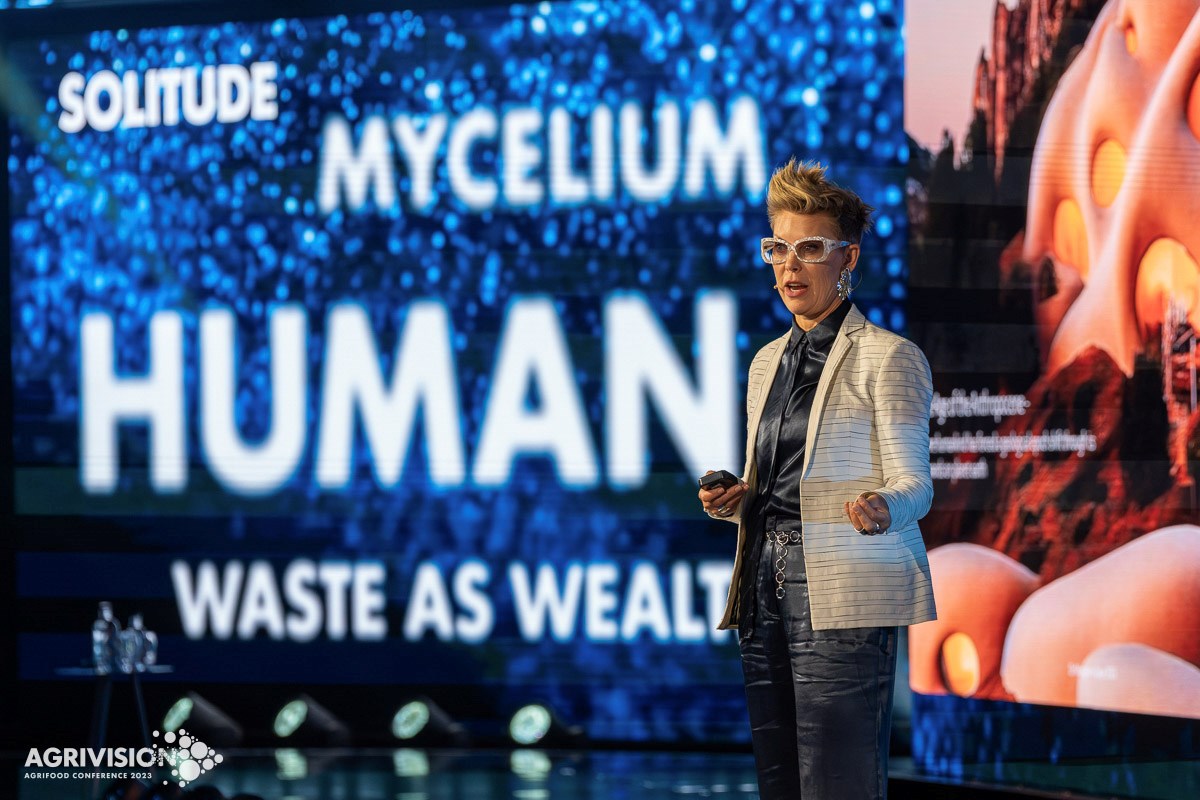
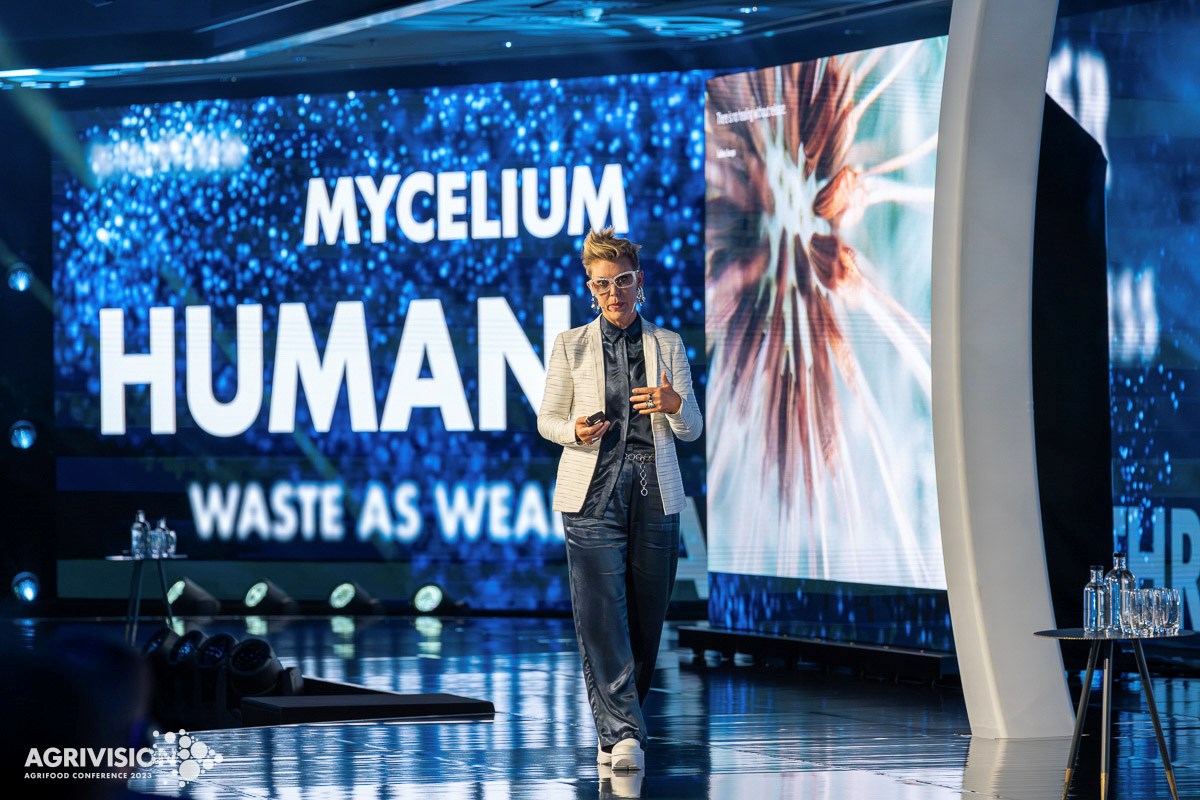
Dancing with complexity: the key to coping with today’s changing environment
Our world is becoming more and more complex – and the first step to helping us navigate the challenges we face is understanding what this really means. At our recent AgriVision 2023, Nutreco’s Chief Science Officer Dr. David Bravo said we can not only use complexity to cope with complexity, but also turn it into a competitive advantage.
A learning paradigm built on predictability
For centuries, our educational paradigm has been based on Newtonian doctrine, said Dr. Bravo. It is built around determinism and predictability, and shapes how we look at and respond to our environment. “In Newtonian science, there is no uncertainty – the world is in a steady state, at least for the life span of a generation,” he said.
But this paradigm may be losing its relevance in a world that is increasingly complex, where the risks we face are highly interconnected. “We have the challenge of being ingenious and innovative in an environment impacted by many factors: consumer constraints, war, raw material costs and the creation of different political systems, all of which are fostering continuous change and unpredictability.”
The difference between complex and complicated
Dr. Bravo said that perhaps it is time to change our paradigm and “dance with complexity.” But he said it’s critical to first understand the difference between complexity and complicatedness. “The word ‘complex’ comes from a Latin word that means ‘to weave.’ The opposite of complex is independent. On the other hand, ‘complicated’ comes from the Latin word for ‘to fold.’ The opposite of complicated is simple.”
According to Dr. Bravo, a complex system is made up of many individual agents connecting, interacting and adding value – with a whole that is bigger than its parts, such as a beehive. A complicated system is also made up of many parts and contains “folds” that conceal its inner structure. However, it is predictable and able to eventually be understood. For example, a watch is a complicated system, but with talent, money and the right process, you can create one.
He said misunderstanding the difference between these concepts leads to problems in organizations, especially when they try to make disruptive, innovative moves. “Industries grow by being complicated, but there is always a tipping point when a significant part of the business becomes complex. Companies respond by adding procedures and processes, instead of organizational complexity and connectivity. They tackle complexity as if it was complication.”
Innovation: where complexity and complicatedness clash
Dr. Bravo said that only companies that successfully create an organisation able to link chaos with stability will be thriving and proactive. “But unfortunately, when the environment becomes truly complex, many companies are unable to do this. They start calcifying and lose their capacity to be proactive.”
Dr. Bravo talked about the stage gate process developed around 2000 and still popular today. He said it is a wonderful tool for governing the critical engine of organisations – R&D, strategic marketing, technical marketing and technical sales – that come at the end of the continuum of innovation. But the problem comes in when companies equate the stage gate process with an innovation model. “The truly disruptive, innovative ideas – not the incremental improvements – are developed further upstream. For 25 years I have seen it: innovation is where complexity and complicatedness clash.”
Radical innovation happens at the edge of chaos
He said that at the end of the continuum where R&D development sits, the environment is imminently complicated. “R&D marketing and technical sales teams have the talent to deal with this complication in order to create whatever the company produces. As you go upstream, the environment becomes more complex. People call this the fuzzy, messy end of innovation. And this is where the truly radically different ideas are, the ones that will change the trajectory of an organization. To be performant, this environment needs to be placed at the edge of chaos. Literally.”
Dr. Bravo said that in a science-based industry like the feed industry, every company has an R&D-based innovation model, and many ask the same people to move upstream – which does not always work. Dealing with complicated tasks requires one set of talents – sensing, analysing, categorising, responding – but to be innovative and proactive in complex environment requires a completely different set. “It takes complexity – not complicatedness – to cope with complexity.”
And it means relying on true diversity and inclusivity. “Diversity in terms of how people think, see their environment and respond to it. People comfortable with complexity will act, probe, sense, respond. They will use complex and adaptive systems to create emerging and novel practices.”
The key is connectivity
The absolute key to it all is connectivity. “Connecting complex and complicated environments – not clashing them or trying to turn one into the other – will create value and make a company proactive and successful.” He said the book The End of Certainty by Ilya Prigogine has impacted his thinking on the subject tremendously. “The author believes that we are actually at the beginning of a new scientific era, that is no longer limited to idealised and simplified situations. One that reflects the complexity of the real world of science that views us and our creativity as part of the fundamental trend present at all levels of nature.”
“Proactive and discovery models lead to disruptive development, through which you can turn complexity into a competitive advantage. Because again, dancing with complexity is possible. And I would add, do we have a choice? I don't think so.”
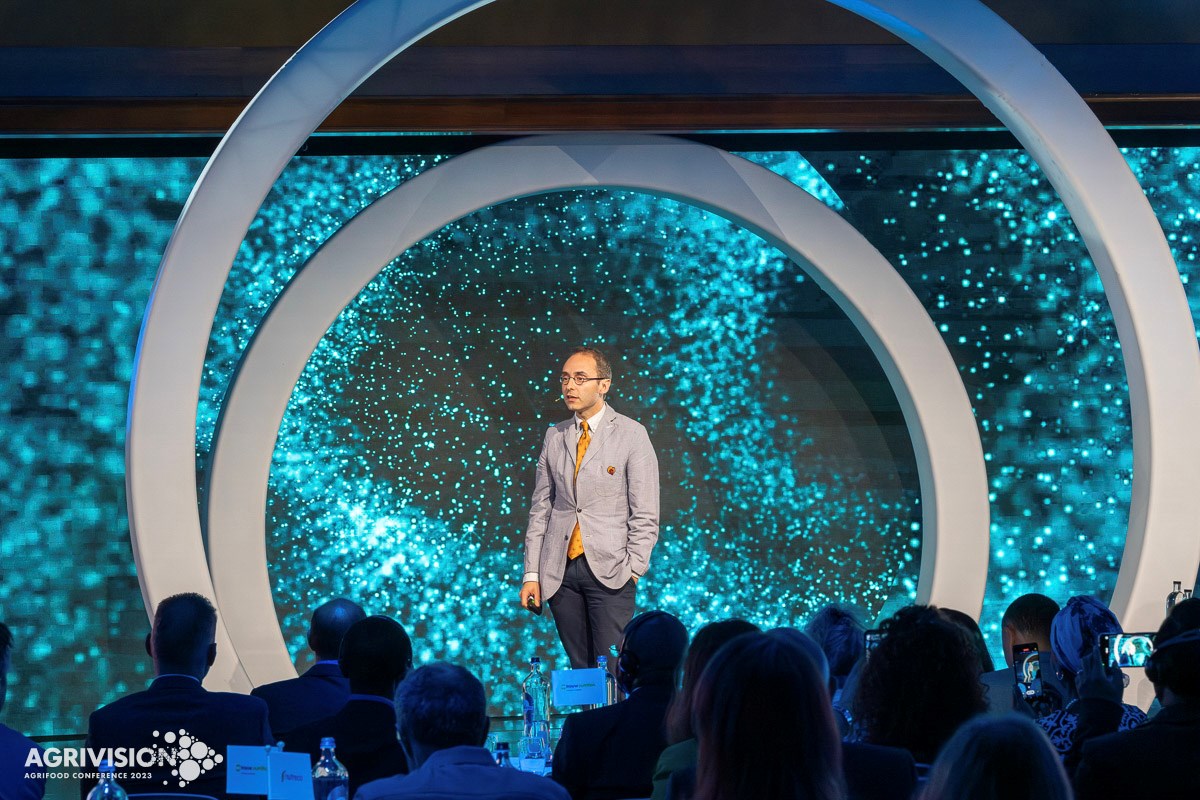
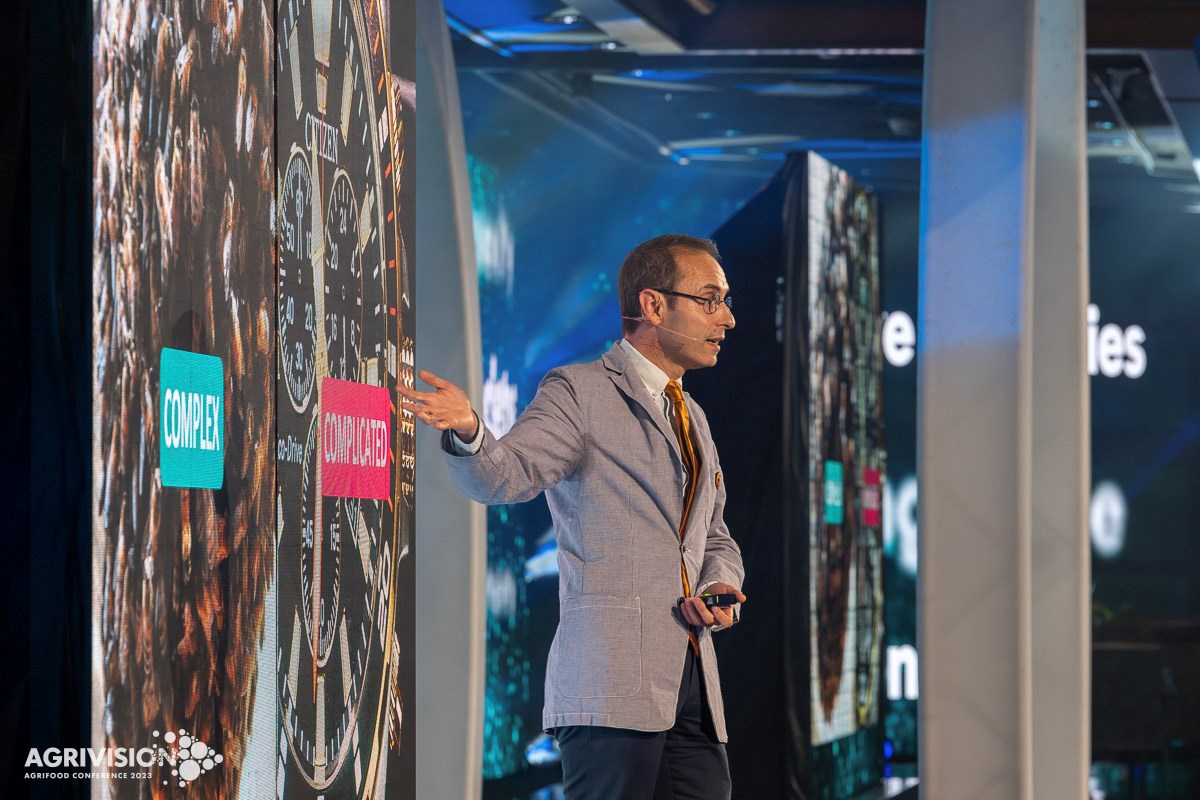
How insect superstars are helping futureproof protein
Talash Huijbers traded fish for flies to build a business pioneering new ways to bring a more circular approach to protein production in Africa. At AgriVision 2023, she told the story of how she is working to make fish feed and other nutritious protein more accessible to Kenyans through her startup, InsectiPro, and what futureproofing protein means to her.
From fish to flies
Huijbers graduated five years ago with a degree in agriculture and went to Kenya intending to farm fish. However, she found that, while Kenya has the perfect climate and water, along with cheap land and labour, the high cost of feed puts fish production out of reach for most of the population. So, she decided to do something about it.
“Futureproofing proteins means to me that protein farmers need to use better – and less – inputs to achieve higher outputs,” said Huijbers. “It needs to be a circular approach. Inputs need to be high in nutrition, and accessible and affordable to everybody.”
According to Huijbers, feed in East Africa makes up 60 to 80% of the cost of production – and the most expensive component is protein. “Currently we use traditional sources such as soy and fishmeal, which pose three challenges in East Africa: accessibility, affordability and quality. Soy prices are very volatile and it’s hard to keep up. Feed prices have gone up more than 50% in the last ten years.” This is what led Huijbers to start thinking about alternatives.
She first looked at moringa because it is drought resistant, but the protein metrics and edibility for animals didn’t make sense. Spirulina was also difficult to grow so far from the ocean. Crickets were expensive to produce. Then Huijbers stumbled on black soldier flies. She found herself Googling them at 5am and wondering “why is nobody else doing this?”
First, Huijbers needed to find out if there was a market for the flies, so she went to the offices of UNGA, a local Nutreco partner company producing human and animal nutrition and animal health products, to present her idea. Before she knew it, they were asking her when she could deliver 500 tons. “That is a very big number for a 23-year-old who's never grown anything before in her life!” Then she realised they meant per month – and that it was only 10% of what they need. “I was like, okay, wow, that is a very big number, but give me five years.”
The birth of InsectiPro
Soon afterwards, she founded InsectiPro in Kenya. Today they have small pilots running in Ghana and Uganda, with around 150 people and one billion insects. Huijbers calls black soldier flies one of their insect superstars. “What do we look for in a superstar? They have to be nutritious, circular, sustainable and profitable. We believe if you implement insects and insect products into food systems, you can grow more food, with higher nutrients, on less land, and sourced locally.”
Insect superstars: black soldier flies
Huijbers says black soldier flies can not only provide a low-cost, sustainable source of protein for feed but have other uses in a circular agriculture system. First, they are a great source of protein for humans and animals, comprising upwards of 40% protein and containing the essential amino acids. “What we are most excited about is the potential to produce this at an industrial level, and I think Africa can be a leader in this because we have the right climate and a low cost of production. And what excites the world most is the adult fly doesn't have a mouth, so it can't sting or bite and it doesn't transfer diseases. And they only lay their eggs in places that smell bad, so there's no risk of contaminating fresh products.”
Black soldier flies are also incredibly good at waste management and composting. Huijbers said they can convert organic waste into protein and frass fertiliser, which is highly nutritious and organic. Kenyans use little fertiliser, partly because of the expense. “But when you teach farmers how to use it, you see very big jumps in production and also nutrition. We're seeing more protein and iron in crops grown with fertiliser. And we've reduced aphids and bacteria and cut bacterial disease by 30% in certain crops.”
“Green regenerative agriculture is also a very important part of our story,” said Huijbers. “Why are we looking at linear value chains when there's so many opportunities to restore, repair and regenerate agricultural supply chains?”
Insect superstars: crickets
InsectiPro has also started growing crickets for human food through a vertical farm in Kenya. “Insects are already eaten by around two billion people. And they’re approved for human consumption in Africa and Europe. Crickets are less resource intensive than more traditional animals; they require less water, feed and space,” said Huijbers. InsectiPro turns them into a powder high in protein, zinc and iron, that be hidden in other products, to provide much-needed human nutrition, especially to the 46% of Africans who are anaemic.
“Africa is expected to have 1.7 billion people by 2030, which means one in five people will live on my home continent, and by 2050 that will be one in four. We have one of the youngest populations and one of the fastest growing middle classes. Around 43% of Africans will be in the middle class by 2030; demand for food is growing, and we see a huge market opportunity here.”
Next steps for a company of the future
For Huijbers, the future is about finding ways to grow. They’re looking at competitive pricing – which she says they are already doing better than their European counterparts – market development, knowledge transfer, creating a good regulatory environment, and getting a hold of great technology that they can “Africanise,” as she calls it, to make sure it works for them. “We’re also busy testing better inclusion rates with partners such as Nutreco. And creating a consistent raw material supply.”
“I think we can overcome all of these challenges with creativity, with innovation, science and technology,” says Huijbers. “And that is why I believe that InsectiPro is where sustainability and profitability meet, making us a company of the future.”